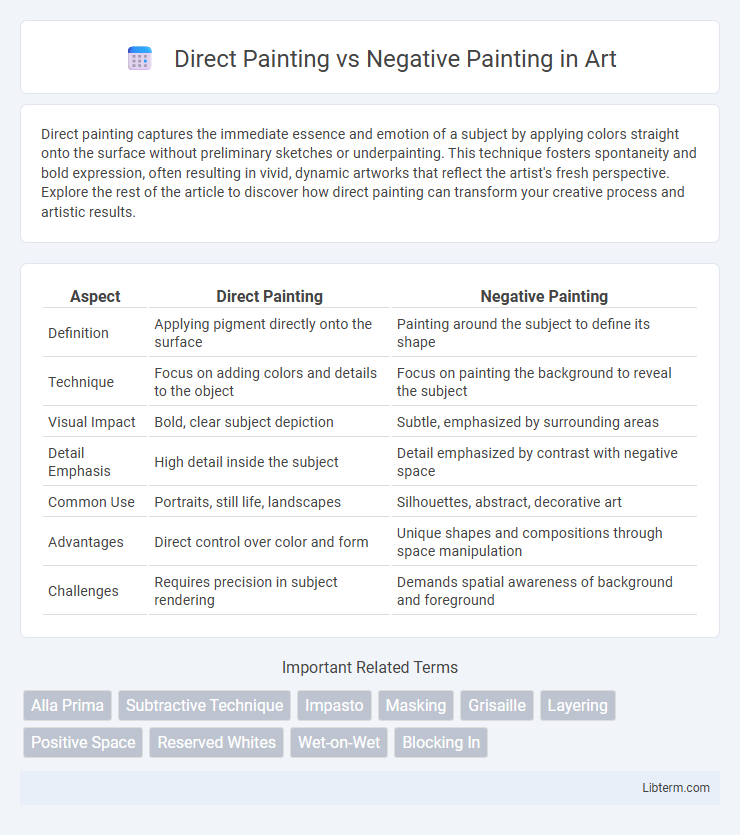Direct painting captures the immediate essence and emotion of a subject by applying colors straight onto the surface without preliminary sketches or underpainting. This technique fosters spontaneity and bold expression, often resulting in vivid, dynamic artworks that reflect the artist's fresh perspective. Explore the rest of the article to discover how direct painting can transform your creative process and artistic results.
Table of Comparison
| Aspect | Direct Painting | Negative Painting |
|---|---|---|
| Definition | Applying pigment directly onto the surface | Painting around the subject to define its shape |
| Technique | Focus on adding colors and details to the object | Focus on painting the background to reveal the subject |
| Visual Impact | Bold, clear subject depiction | Subtle, emphasized by surrounding areas |
| Detail Emphasis | High detail inside the subject | Detail emphasized by contrast with negative space |
| Common Use | Portraits, still life, landscapes | Silhouettes, abstract, decorative art |
| Advantages | Direct control over color and form | Unique shapes and compositions through space manipulation |
| Challenges | Requires precision in subject rendering | Demands spatial awareness of background and foreground |
Introduction to Direct and Negative Painting
Direct painting involves applying pigments straight onto the canvas, emphasizing bold brushstrokes and vibrant color layering that captures immediacy and spontaneity. Negative painting, by contrast, focuses on defining shapes and forms by painting around the subject, using background tones to create contrast and highlight the positive space indirectly. Both techniques play unique roles in art composition, guiding visual focus through either additive color application or subtractive space manipulation.
Defining Direct Painting Techniques
Direct painting techniques involve applying pigment straight onto the canvas or surface without pre-drawing or masking areas, emphasizing spontaneity and bold brushwork. This method allows artists to build up layers of color and texture dynamically, often highlighting the immediacy of gesture and vibrant chromatic contrasts. It contrasts sharply with negative painting, where the focus lies in painting around the subject to define shapes through surrounding colors and negative space.
Understanding Negative Painting Methods
Negative painting techniques involve applying paint around the subject rather than directly on it, creating contrast by highlighting the unpainted areas as the main focus. This method requires careful control of edges and layering to allow background colors to define shape and form, making it essential for artists to understand transparency and color interaction. Mastery of negative painting enhances depth, spatial relationships, and adds an intriguing visual tension compared to direct painting methods.
Key Differences Between Direct and Negative Painting
Direct painting involves applying paint straight onto the canvas to create the image, emphasizing immediate color placement and brushwork. Negative painting focuses on painting around the subject to define its shape by the absence of paint or contrasting color, highlighting the background rather than the object itself. The key difference lies in direct painting building the form from positive shapes, whereas negative painting constructs form through the manipulation of surrounding spaces.
Materials and Tools for Each Approach
Direct painting utilizes materials such as acrylics, oils, or watercolors applied straight onto the surface with brushes, palette knives, or sponges to build color and texture layer by layer. Negative painting requires masking fluids, resist techniques, or fine detail brushes to preserve the background while adding color around shapes, often using transparent or semi-transparent watercolors or inks for precise control. Both approaches demand specific tools tailored to their techniques: direct painting favors bold brushes and palette knives for expressive strokes, whereas negative painting relies on delicate brushes and masking tools for fine, controlled edges.
Visual Effects: Direct vs Negative Painting
Direct painting produces vibrant, bold colors by applying paint straight onto the canvas, creating strong contrasts and defined shapes that command attention. Negative painting emphasizes the space around the subject, using lighter or contrasting backgrounds to shape forms implicitly, resulting in a more subtle, layered visual effect. These techniques enhance composition differently: direct painting highlights form and color intensity, while negative painting prioritizes spatial relationships and depth.
When to Use Direct Painting
Direct painting is ideal for capturing spontaneous expressions and vibrant color interactions, allowing artists to apply paint straight onto the canvas without preliminary underpainting. It excels in creating bold, immediate effects and is preferred when working with opaque mediums like oils or acrylics to convey energy and texture. This method suits projects requiring quick execution and dynamic brushwork, often used in plein air painting and impressionistic styles.
When to Use Negative Painting
Negative painting is ideal for creating intricate backgrounds or emphasizing the foreground by painting around objects rather than directly on them, especially in watercolor and acrylic techniques. Use negative painting when fine details or delicate separation between elements are needed without hard lines, allowing for a softer, more natural transition. This technique is particularly effective in botanical art, landscapes, and compositions requiring depth and contrast without compromising the integrity of the main subject.
Common Challenges and Solutions
Direct painting often faces challenges with color blending and layer control, leading to unintended mixing or muddy tones, while negative painting struggles with precision and maintaining defined edges around focal areas. Both techniques require careful planning and patience; solutions include utilizing masking tools for negative painting to preserve sharp boundaries and applying glazing methods in direct painting to build color depth gradually without overmixing. Mastering brush control and understanding paint transparency are essential to overcome these common issues and achieve desired visual effects.
Conclusion: Choosing the Right Painting Technique
Direct painting delivers vibrant, immediate results by applying color straight onto the surface, ideal for artists seeking boldness and spontaneity. Negative painting, which involves painting around shapes to define them, excels in creating depth and intricate details, offering precision and control. Selecting the right painting technique depends on the artist's desired expression, with direct painting suited for dynamic compositions and negative painting for refined, layered effects.
Direct Painting Infographic

 libterm.com
libterm.com